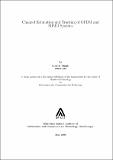Please use this identifier to cite or link to this item:
http://drsr.daiict.ac.in//handle/123456789/243| Title: | Channel estimation and tracking OFDM and MIMO systems |
| Authors: | Vijaykumar, Chakka Singh, Smriti |
| Keywords: | MIMO systems MIMO Multiple Input Multiple Output Wireless LANs Orthogonal frequency division multiplexing Digital communications Wireless communication systems |
| Issue Date: | 2009 |
| Publisher: | Dhirubhai Ambani Institute of Information and Communication Technology |
| Citation: | Singh, Smriti (2009). Channel estimation and tracking OFDM and MIMO systems. Dhirubhai Ambani Institute of Information and Communication Technology, xi, 66 p. (Acc.No: T00206) |
| Abstract: | In this thesis, To estimate and track the slow Time varying channels in OFDM and MIMO systems. In first part: we have used a two-dimensional recursive least square adaptive channel estimation technique is used. In orthogonal frequency division multiplexing (OFDM) system, time- and frequency-domain two-dimensional minimum mean square error (2D-MMSE) channel estimation is optimum. However, accurate channel statistics, which are often time varying and unavailable in practice, are required to realize it.2DRLS adaptive channel estimation does not require accurate channel statistics, and at the same time can make full use of time and frequencydomain correlations of the frequency response of time-varying wireless channels. With properly chosen parameters, 2D-RLS adaptive channel estimation can converge into the steady state in only several OFDM symbols time. Although the 2D RLS algorithm creates adaptive letters with a fast convergence speed, this algorithm diverges when the inverse correlation matrix of input loses the properties of positive definiteness or Hermitian symmetry. The diverging of the 2D RLS algorithm same as standard RLS limits the application of this algorithm. We proposed a QR decomposition-based 2DRLS (inverse QR-2DRLS) algorithm, which can resolve this instability. Instead of propagating inverse of correlation matrix of the input signal, it propogates square root of inverse correlation matrix of the input signal. Therefore, this algorithm guarantees the property of positive definiteness and is more numerically stable than the standard RLS algorithm. The parallel implementation of the inverse QR-2DRLS algorithm permits a direct computation of the least squares weight coefficients matrix MATLAB simulations demonstrate that performance of QR-2D-RLS adaptive channel estimation is same as of 2D-RLS adaptive channel estimation and is very effective and suitable for a broad range of channel conditions. In the second part of the thesis: Since, In MIMO systems, accurate channel estimation is necessary to fully exploit the benefits of spatial diversity offered by such systems. And for time-varying channels, these channel estimates should also be updated accordigly to track the variation of channel. we have used One such method of channel estimation using adaptive SVD updates for channel estimation and tracking of slow-time varying channels in MIMO system. The channel estimates are then further used for symbol detection using V-BLAST/ZF detection algorithm which ensures interference reduction and give better BER vs. SNR performance than SVD based MIMO system. |
| URI: | http://drsr.daiict.ac.in/handle/123456789/243 |
| Appears in Collections: | M Tech Dissertations |
Files in This Item:
| File | Description | Size | Format | |
|---|---|---|---|---|
| 200711015.pdf Restricted Access | 1.38 MB | Adobe PDF |  View/Open Request a copy |
Items in DSpace are protected by copyright, with all rights reserved, unless otherwise indicated.
